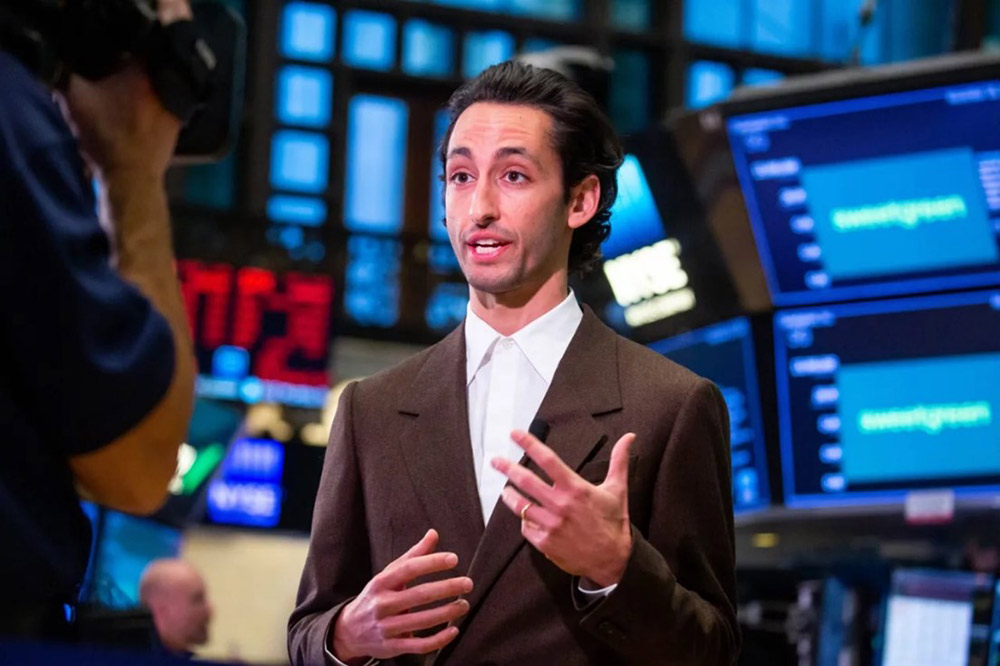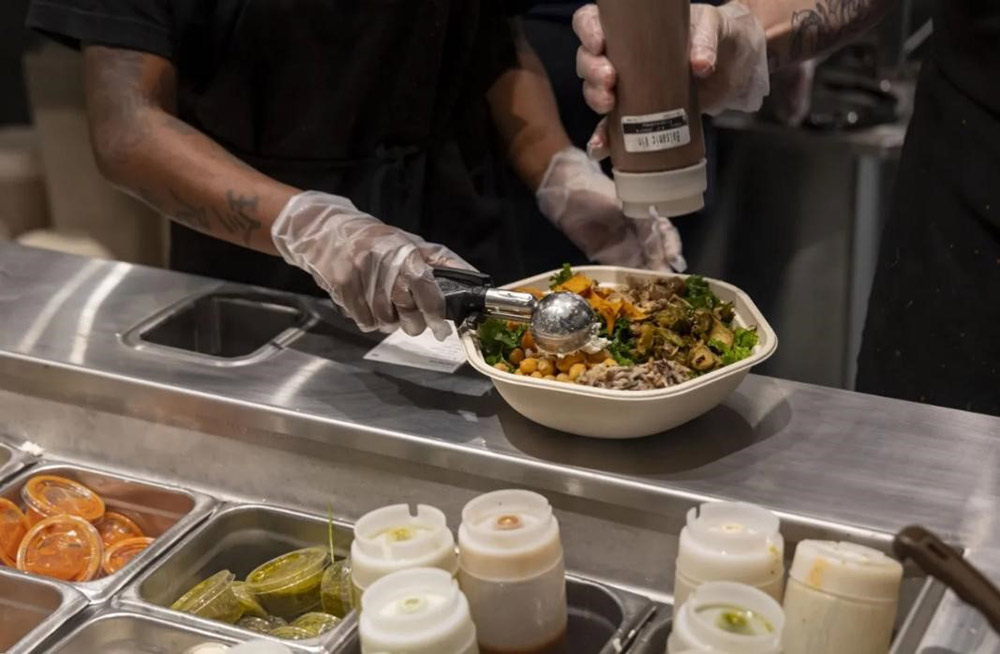
• Sweetgreen无疑是美国较为健康的快餐选择之一,但也是价格最为昂贵的快餐之一。沙拉均价高达16美元,不过该公司首席执行官鼓励顾客不要只考虑当下单次餐食的开销,而应着眼于饮食选择对健康的长期影响。
消费者信心正急剧下滑,背后有着切实缘由。自2020年以来,商品价格涨幅超23%,民众对唐纳德·特朗普总统推行的新关税政策以及通货膨胀也心存担忧。
然而,有位首席执行官恳请消费者不要仅着眼于产品当下的价格,而应将目光投向其所能带来的长远益处。Sweetgreen首席执行官乔纳森·内曼告诉《纽约时报》,当人们权衡某样事物的成本时,有时必须考虑其总成本。
内曼曾发问:“这仅是食材的成本,可当你选择食用某些食物时,它会给健康带来何种代价?环境承受的成本又是多少?”在21世纪00年代中期,还在乔治城大学求学的内曼创立了这家休闲快餐沙拉连锁店。该公司于2021年末上市,目前在全美拥有250家门店,并且有志于将该品牌打造成沙拉界的“星巴克”。
2007年,内曼和商业伙伴尼古拉斯·雅梅(Nicolas Jammet)以及纳撒尼尔·鲁(Nathaniel Ru)在华盛顿特区大学校园周边开设了首家Sweetgreen餐厅。彼时,距离纪录片《超码的我》(Super Size Me)首映仅过去约三年,这部作品掀起了公众对传统美式快餐短期及长期影响的探讨。
内曼对《纽约时报》表示:“我们将摒弃上一代的快餐模式。”
不过,更健康的餐食选择势必伴随更高成本,消费者支付价格也会随之攀升。据专业美食测评网站Eater报道,Sweetgreen的沙拉平均售价约为16美元,而巨无霸套餐均价约为10美元。
内曼告诉《纽约时报》:“人们不仅在为食物的风味买单,还在为食物源自手工制作买单,以及为农民与员工获得公平报酬买单。”
不过,Sweetgreen使用来自农场和农产品合作伙伴的新鲜食材,菜单以蔬菜、谷物和优质蛋白为主——尽管它最近推出了空气炸锅炸制的波纹薯条,相较麦当劳薯条,热量少了约160卡路里。该公司还在一则广告中宣称,这款薯条仅含五种配料,而竞争对手的薯条则包含大量难以辨认的添加剂。
内曼在2024年接受《华尔街日报》采访时表示:“大多数公司都是集中加工食品,然后运往全国各地。为了最大限度保证食物的口感和新鲜度,我们认为食物应在离顾客就餐地点更近的地方制作。”

此外,据《财富》杂志前记者简·蒂尔(Jane Thier)称,买份Sweetgreen餐食“犒劳”自己实际上可能比购买杂货更为划算:美国劳工统计局的数据显示,单人每月在杂货采购上的平均支出高达504美元。
Sweetgreen未立即回应《财富》杂志要求进一步置评的请求。
尽管Sweetgreen最新财报显示,2024财年公司利润近6.77亿美元,但仍录得约9000万美元净亏损。Sherwood News分析指出,以沙拉均价16美元计算,该公司每份餐食亏损约2.26美元。财报显示,成本最高的部分包括食品、饮料、包装、人工及管理成本。
Sweetgreen另一项重要成本投入,聚焦于技术领域,用于支持其自取服务、配送服务,以及利用人工智能为顾客提供建议并维持其忠诚度计划。
内曼告诉《华尔街日报》:“我们实现净利润盈利的途径有几项关键因素。其一,继续扩大经营规模;其二,增加现有门店的销售额;其三,严格管控成本架构,以确保增量利润能够转化为实际利润。”(财富中文网)
译者:中慧言-王芳
• Sweetgreen无疑是美国较为健康的快餐选择之一,但也是价格最为昂贵的快餐之一。沙拉均价高达16美元,不过该公司首席执行官鼓励顾客不要只考虑当下单次餐食的开销,而应着眼于饮食选择对健康的长期影响。
消费者信心正急剧下滑,背后有着切实缘由。自2020年以来,商品价格涨幅超23%,民众对唐纳德·特朗普总统推行的新关税政策以及通货膨胀也心存担忧。
然而,有位首席执行官恳请消费者不要仅着眼于产品当下的价格,而应将目光投向其所能带来的长远益处。Sweetgreen首席执行官乔纳森·内曼告诉《纽约时报》,当人们权衡某样事物的成本时,有时必须考虑其总成本。
内曼曾发问:“这仅是食材的成本,可当你选择食用某些食物时,它会给健康带来何种代价?环境承受的成本又是多少?”在21世纪00年代中期,还在乔治城大学求学的内曼创立了这家休闲快餐沙拉连锁店。该公司于2021年末上市,目前在全美拥有250家门店,并且有志于将该品牌打造成沙拉界的“星巴克”。
2007年,内曼和商业伙伴尼古拉斯·雅梅(Nicolas Jammet)以及纳撒尼尔·鲁(Nathaniel Ru)在华盛顿特区大学校园周边开设了首家Sweetgreen餐厅。彼时,距离纪录片《超码的我》(Super Size Me)首映仅过去约三年,这部作品掀起了公众对传统美式快餐短期及长期影响的探讨。
内曼对《纽约时报》表示:“我们将摒弃上一代的快餐模式。”
不过,更健康的餐食选择势必伴随更高成本,消费者支付价格也会随之攀升。据专业美食测评网站Eater报道,Sweetgreen的沙拉平均售价约为16美元,而巨无霸套餐均价约为10美元。
内曼告诉《纽约时报》:“人们不仅在为食物的风味买单,还在为食物源自手工制作买单,以及为农民与员工获得公平报酬买单。”
不过,Sweetgreen使用来自农场和农产品合作伙伴的新鲜食材,菜单以蔬菜、谷物和优质蛋白为主——尽管它最近推出了空气炸锅炸制的波纹薯条,相较麦当劳薯条,热量少了约160卡路里。该公司还在一则广告中宣称,这款薯条仅含五种配料,而竞争对手的薯条则包含大量难以辨认的添加剂。
内曼在2024年接受《华尔街日报》采访时表示:“大多数公司都是集中加工食品,然后运往全国各地。为了最大限度保证食物的口感和新鲜度,我们认为食物应在离顾客就餐地点更近的地方制作。”
此外,据《财富》杂志前记者简·蒂尔(Jane Thier)称,买份Sweetgreen餐食“犒劳”自己实际上可能比购买杂货更为划算:美国劳工统计局的数据显示,单人每月在杂货采购上的平均支出高达504美元。
Sweetgreen未立即回应《财富》杂志要求进一步置评的请求。
尽管Sweetgreen最新财报显示,2024财年公司利润近6.77亿美元,但仍录得约9000万美元净亏损。Sherwood News分析指出,以沙拉均价16美元计算,该公司每份餐食亏损约2.26美元。财报显示,成本最高的部分包括食品、饮料、包装、人工及管理成本。
Sweetgreen另一项重要成本投入,聚焦于技术领域,用于支持其自取服务、配送服务,以及利用人工智能为顾客提供建议并维持其忠诚度计划。
内曼告诉《华尔街日报》:“我们实现净利润盈利的途径有几项关键因素。其一,继续扩大经营规模;其二,增加现有门店的销售额;其三,严格管控成本架构,以确保增量利润能够转化为实际利润。”(财富中文网)
译者:中慧言-王芳
• Sweetgreen is undoubtedly one of the healthier fast-food options in the U.S., but it’s also one of the most expensive. Salads cost about $16 on average, but the company’s CEO encourages customers to think beyond today’s price of a meal and instead consider the long-term impacts of what you eat.
Consumer confidence is plummeting—and for good reason. Since 2020, prices on goods have jumped more than 23%, and there’s fear surrounding President Donald Trump’s new tariff policies as well as inflation.
But one CEO is imploring consumers to think beyond today’s price of their product, championing the long-term benefits it can bring. Sweetgreen CEO Jonathan Neman told the New York Times that when you think about the cost of something, you have to sometimes think about the total cost of it.
“There’s the cost to you, but when you eat certain things, what’s the cost to your health? What’s the cost to the environment?” said Neman, who launched the fast-casual salad chain in the mid-2000s while he was a student at Georgetown University. The company went public in late 2021 and now has 250 locations across the U.S.—and aspirations to make the brand the Starbucks of salad.
Neman and his business partners, Nicolas Jammet and Nathaniel Ru, opened their first Sweetgreen near campus in Washington, D.C., in 2007. This was just about three years after the premiere of the documentary Super Size Me, which initiated conversations about the short- and long-term impacts of traditional American fast food.
“We were going to be rejecting the fast food of the previous generation,” Neman told the NYT.
But healthier options inevitably mean a higher cost—and subsequently price for consumers. The average Sweetgreen salad costs about $16, according to Eater, while the average price of a Big Mac meal is about $10.
“People are paying not only for the quality of the taste in the food, but the fact that it’s made by hand, the fact that we pay our farmers and our team members fairly,” Neman told NYT.
However, Sweetgreen uses fresh ingredients from farm and produce partners, and the menu largely consists of vegetables, grains, and proteins—although it recently launched air-fried ripple fries that are about 160 fewer calories than McDonald’s fries. The company also touted in an advertisement the fries have just five ingredients, while competitors include a litany of unrecognizable additives.
“Most companies process their food centrally and ship it out around the country,” Neman told the Wall Street Journal in 2024. “In order to maximize the taste and the freshness, we believe that food should be made closer to where the guests are eating the food.”
Plus, “treating” yourself to Sweetgreen could actually end up being cheaper than buying groceries: Take it from former Fortune reporter Jane Thier. The average monthly cost of groceries for a single person is $504, BLS data shows.
Sweetgreen didn’t immediately respond to Fortune’s request for additional comment.
Although company profits were up to nearly $677 million for fiscal 2024, according to Sweetgreen’s most recent earnings report, it still faced a net loss of about $90 million. Assuming a $16 average price for a salad from Sweetgreen, the company loses about $2.26 per meal, a Sherwood News analysis showed. Some of the highest costs include food, drinks, packaging, labor, and administrative costs, the earnings report shows.
Another major cost for Sweetgreen has been investing in technology to power its pickup services, deliveries, and AI to provide suggestions to customers and maintain its loyalty program.
“Our path to profitability on a net income basis comes from a few levers,” Neman told WSJ. “The first is continuing to grow our footprint. Second is growing sales in existing stores. The third is being very disciplined on our cost structure to make sure the incremental profit we’re making is flowing through the bottom line.”






